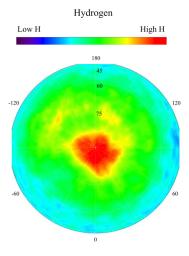
|
Map of Martian Polar Hydrogen
- Click the image above for a larger view
- Full-Res JPEG (1163 x 1579) (117.0 kB)
- Full-Res TIFF (1163 x 1579) (2.1 MB)
Caption:
This gamma ray spectrometer map centered on the north pole of Mars is based on gamma-rays from the element hydrogen. In this region, hydrogen is mainly in the form of water ice. Regions of high ice content are shown in red and those low in ice content are shown in blue. The very ice-rich region at the north pole is due to a permanent polar cap of water ice on the surface. Elsewhere in this region, the ice is buried under several to a few tens of centimeters of dry soil. The sub-surface ice is not uniformly distributed in the north, but varies with both latitude and longitude. In the north, the soil is well over 50 percent ice, which is more than can be accommodated by just filling the pore space in pre-existing soil. This high ice content implies that the ice may have been slowly co-deposited with dust in the past when conditions were wetter. Deposition of ice by this process means it is more likely that the ice deposits are very thick and may even be deep enough to have liquid water at their base.
Background Info:
NASA's Jet Propulsion Laboratory manages the 2001 Mars Odyssey mission for NASA's Office of Space Science, Washington, D.C. The gamma ray spectrometer was provided by the University of Arizona, Tucson. Lockheed Martin Astronautics, Denver, Colo., is the prime contractor for the project, and developed and built the orbiter. Mission operations are conducted jointly from Lockheed Martin and from JPL, a division of the California Institute of Technology in Pasadena.
Cataloging Keywords:
| Name | Value | Additional Values |
|---|---|---|
| Target | Mars | |
| System | ||
| Target Type | Planet | |
| Mission | 2001 Mars Odyssey | |
| Instrument Host | Mars Odyssey | |
| Host Type | Orbiter | |
| Instrument | Gamma Ray Spectrometer (GRS) | |
| Detector | ||
| Extra Keywords | Color, Dust, Map, Water | |
| Acquisition Date | ||
| Release Date | 2003-03-13 | |
| Date in Caption | ||
| Image Credit | NASA/JPL/University of Arizona | |
| Source | photojournal.jpl.nasa.gov/catalog/PIA04254 | |
| Identifier | PIA04254 | |
